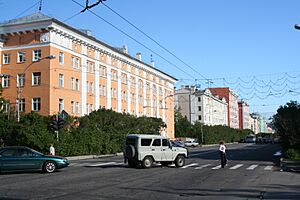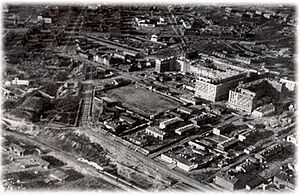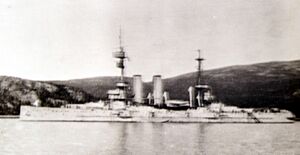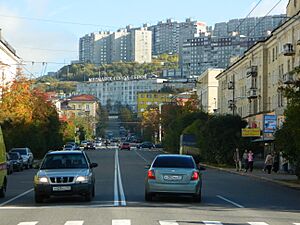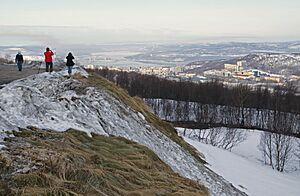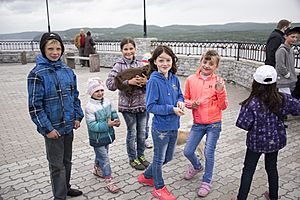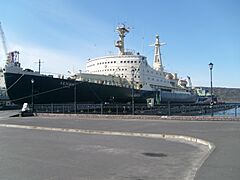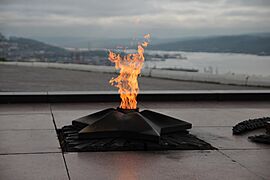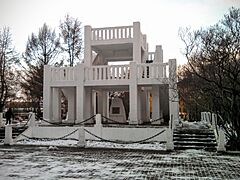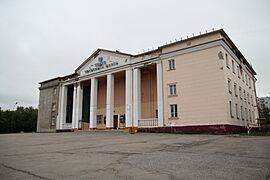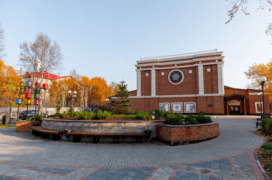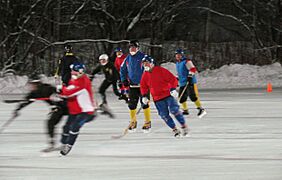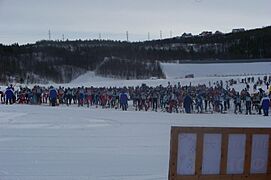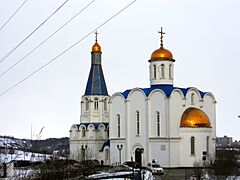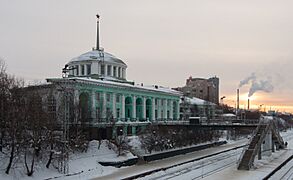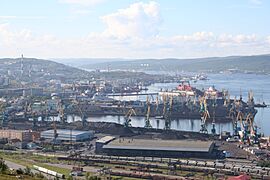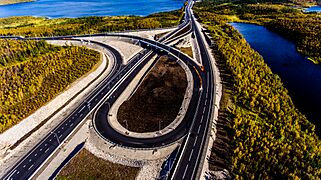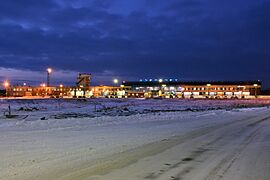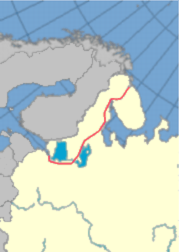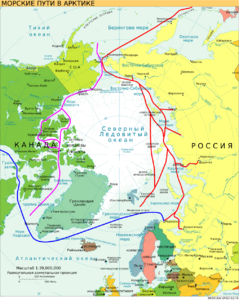Murmansk facts for kids
Quick facts for kids Murmansk (English)Мурманск (Russian) Мурман ланнҍ (Kildin Sami) Murmánska (Northern Sami) Muurman (Skolt Sami) |
|
|---|---|
| - City - | |
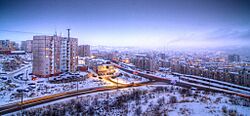 Murmansk skyline |
|
|
|
|
| City Day | October 4 |
| Administrative status | |
| Country | Russia |
| Federal subject | Murmansk Oblast |
| Administratively subordinated to | City of Murmansk |
| Municipal status | |
| Urban okrug | Murmansk Urban Okrug |
| Head/Mayor | Dmitry Filippov (Head) Evgeniy Nikora (Mayor) |
| Representative body | Council of Deputies |
| Statistics | |
| Time zone | MSK (UTC+04:00) |
| Official foundation date (see text) |
October 4, 1916 |
| City status since | July 19, 1916 |
| Postal code(s) | 183000–183099 |
| Dialing code(s) | +7 8152 |
| [citymurmansk.ru Official website] | |
Murmansk is a major port city in the far northwest of Russia. It is the main city of Murmansk Oblast. The city is located on the Kola Bay, which is an inlet of the Barents Sea. Most of Murmansk is on the east side of this inlet. It is also in the northern part of the Kola Peninsula. The city is about 108 kilometers (67 miles) from the border with Norway and 182 kilometers (113 miles) from the border with Finland.
Murmansk has a special advantage: the North Atlantic Current. This warm ocean current keeps the waters around the city mostly free of ice all year. This is unusual because Murmansk is located more than 2 degrees north of the Arctic Circle. It has good connections to the rest of Europe by road and railway. It even has the world's northernmost trolleybus system. This makes Murmansk different from other isolated Arctic ports like Dikson in Siberia.
Even though Murmansk had a building boom in the early 1900s, its population has been decreasing since the Cold War. In 2021, its population was 270,384. Despite this, it is still the world's largest city north of the Arctic Circle. It has over 100,000 more people than Norilsk, another Russian city in the Arctic. Murmansk is a very important port in the Arctic Ocean.
Contents
- What's in a Name?
- A Look Back: Murmansk's History
- How Murmansk is Organized
- Murmansk's Climate and Geography
- People of Murmansk
- Museums and Monuments
- Arts and Culture
- Sports in Murmansk
- Religious Sites
- Economy and Transport
- Learning and Education
- Cities Murmansk is Connected To
- Famous People from Murmansk
- Images for kids
- See also
What's in a Name?
The name Murmansk comes from an old Russian word, Murman. This word was used to refer to Norwegians. It likely came from an old Norse word meaning "north man." This name also gave rise to the names of the Murman Coast and the Kola Peninsula.
A Look Back: Murmansk's History
Murmansk was the last city founded in the Russian Empire. During World War I in 1915, Russia needed a way to receive military supplies from its allies. A railroad was built from Petrozavodsk to an ice-free spot on the Murman Coast in the Russian Arctic.
This railway end point became known as the Murman station. Soon, it had a port, a naval base, and a settlement. The population grew quickly, becoming larger than nearby towns. On July 19, 1916, the town was officially named Romanov-on-Murman, after the Russian royal family, the Romanovs. The official founding ceremony was on October 4, 1916. After the February Revolution in March 1917, the town was renamed Murmansk on April 16, 1917.
During the winter of 1917, the British North Russia Squadron, a group of British warships, was based in Murmansk. From 1918 to 1920, during the Russian Civil War, Western powers and White Army forces occupied the town.
In 1926, Murmansk got its own local government for the first time. Later, in 1927, it became the administrative center of the Murmansk Okrug within the Leningrad Oblast. Over time, some smaller towns and villages nearby were merged into Murmansk, making it larger. In 1938, Murmansk became a separate administrative area, equal to a district. This status continued when Murmansk Okrug became Murmansk Oblast in May 1938.
During World War II, Murmansk was a crucial link for the Soviet Union to the Western world. Large amounts of military equipment, manufactured goods, and raw materials were sent to the Soviet Union through Murmansk. These supplies arrived via the Arctic convoys.
German forces tried to capture Murmansk in 1941 as part of Operation Silver Fox. However, strong Soviet resistance, harsh weather, and difficult terrain stopped them. The Germans could not take the city or cut off the important railway line and ice-free harbor. The Luftwaffe (German air force) bombed Murmansk 792 times during the war. The city was severely damaged, similar to Leningrad and Stalingrad.
Murmansk's strong resistance was honored on May 6, 1985, when it was given the title of Hero City. During the Cold War, Murmansk was a key center for Soviet submarine and icebreaker activities. Today, the nearby naval base of Severomorsk is still the headquarters of the Russian Northern Fleet.
In 1974, a huge 35.5-meter (116 ft) tall statue called Alyosha was built. It shows a Soviet World War II soldier. The Hotel Arctic opened in 1984 and became the tallest building north of the Arctic Circle. On January 1, 2015, the nearby town of Roslyakovo was merged into Murmansk, making the city's territory larger.
How Murmansk is Organized
Murmansk is an administrative unit that has the same status as a district. It is also organized as the Murmansk Urban Okrug for local government.
City Sections
As of 2012, Murmansk is divided into three administrative areas called okrugs:
- Leninsky (named after Lenin)
- Oktyabrsky (named after October)
- Pervomaysky (named after First May)
These city districts have been created and changed several times throughout Murmansk's history.
Murmansk's Climate and Geography
Murmansk has a subarctic climate. This means it has long, cold winters and short, cool summers. Temperatures are usually below freezing from October to May. In winter, temperatures often drop below -20 degrees Celsius (-4 degrees Fahrenheit).
Murmansk's short summer is mild, with average high temperatures in July reaching over 17 degrees Celsius (63 degrees Fahrenheit). The city gets a bit more rain in summer than in winter. It receives about 500 millimeters (20 inches) of precipitation each year.
Because it's so far north, Murmansk experiences the "midnight sun" from May 22 to July 23 (63 days). During this time, the sun never fully sets. It also has a period of continuous darkness called the polar night, which lasts from December 2 to January 10 (40 days).
The coldest temperature ever recorded in Murmansk was -39.4 degrees Celsius (-38.9 degrees Fahrenheit). The warmest was 32.9 degrees Celsius (91.2 degrees Fahrenheit). Murmansk, like other Arctic places, has been affected by global warming in recent years.
People of Murmansk
| Historical population | ||
|---|---|---|
| Year | Pop. | ±% |
| 1926 | 8,716 | — |
| 1939 | 117,069 | +1243.2% |
| 1959 | 221,874 | +89.5% |
| 1970 | 308,642 | +39.1% |
| 1979 | 380,817 | +23.4% |
| 1989 | 468,039 | +22.9% |
| 2002 | 336,137 | −28.2% |
| 2010 | 307,257 | −8.6% |
| 2021 | 270,384 | −12.0% |
| Source: Census data | ||
In 2010, the population of Murmansk was 307,257 people. About 45.9% were men and 54.1% were women. Since the dissolution of the Soviet Union, the city's population has been decreasing. This is partly because the large military facilities that supported the city have become smaller. Most of the people in Murmansk are Russians. There are also smaller groups of Ukrainian and Belarusian people living there.
Museums and Monuments
Murmansk has two main museums: the Murmansk Oblast Museum and the Murmansk Oblast Art Museum. There are also several smaller museums. The city has three professional theaters, many libraries, and a aquarium.
You can visit the decommissioned Lenin, which was the world's first nuclear-powered icebreaker. It is now a museum ship. The Alyosha Monument, Murmansk is a large memorial dedicated to the soldiers who defended the Soviet Arctic during World War II. The main square in Murmansk is called Five Corners, Murmansk.
-
Monument to the victims of the intervention of 1918–1920
Arts and Culture
Murmansk has three professional theaters. The oldest is the Murmansk Puppetry, which opened in 1933. The largest is the Murmansk Regional Drama Theater, opened in 1939. The Drama Theater of the Northern Fleet opened in 1946.
Sports in Murmansk
The city has football (soccer) teams. FC Sever Murmansk used to play in a Russian league but stopped in 2014 due to money problems. A new team, FC Murmansk, was founded in 2022.
The Bandy club Murman plays in the top Russian league. Their home arena is Stadium Stroitel, which can hold 5,000 people. Murmansk is also one of only three cities with a team in the female bandy league, called Arktika.
Because of its location near the North Pole and the Polar Night, Murmansk hosts special sports festivals. These include the North Festival Polar Olympiad and the Sun Festival. The North Festival has been held every year since 1934, with teams from Norway, Finland, Sweden, Ukraine, Belarus, and the Baltic countries taking part.
Religious Sites
To celebrate the city's 85th anniversary, the beautiful white Church of the Saviour on the Waters was built by the shore. It was designed to look like the White Monuments of Vladimir and Suzdal.
Many religious groups are active in Murmansk. The largest is the Russian Orthodox Church. Murmansk is the center of its Murmansk and Monchegorsk diocese. The city has about a dozen Orthodox churches.
Economy and Transport
Media
Murmansk's evening newspaper is Vecherniy Murmansk, which has been published since 1991.
Getting Around Murmansk
The Port of Murmansk is very important because it stays ice-free all year, thanks to the warm North Atlantic Current. It is a major place for fishing and shipping. Murmansk is also home to Atomflot, which is the world's only fleet of nuclear-powered icebreakers.
The Port of Murmansk is the main office for the Northern Sea Route (Sevmorput), which manages shipping in the Russian Arctic. In 2018, the Russian government gave the main responsibility for the Northern Sea Route to Rosatom, which runs the nuclear icebreaker fleet based in Murmansk.
Murmansk is connected to St. Petersburg by the Kirov Railway. It is also linked to the rest of Russia by the M18 Kola Motorway. Murmansk Airport offers flights to Moscow and St. Petersburg. Within the city, people use buses and trolleybuses for local transport.
-
A road interchange near Murmansk
-
Kirov Railway connects Murmansk city and Saint Petersburg.
-
Arctic Bridge sea route linking Murmansk to the Canadian port of Churchill, Manitoba.
The Arctic Bridge
Murmansk is planned to be the Russian end of the Arctic Bridge. This is a sea route that would connect Murmansk to the Canadian port of Churchill, Manitoba. Even though this route is not yet fully used for commercial shipping, Russia is very interested in it. The Arctic Bridge could become a major trade route between North America, Europe, and Asia.
Learning and Education
Murmansk is home to several important educational institutions. These include the Murmansk State Technical University and the Murmansk Arctic State University. There is also the Murmansk Institute of Humanities and the Murmansk College of Arts, which is the only art school in the Kola Peninsula. The city has many primary and secondary schools. There is also a branch of the Naval Academy in Murmansk, where students train to become officers in the Russian Navy.
Cities Murmansk is Connected To
Murmansk is twinned with several cities around the world. This means they have special friendly relationships and often share cultural exchanges.
Some cities that were formerly twinned with Murmansk have paused or cancelled their agreements:
Famous People from Murmansk
Many notable people have come from Murmansk, including:
- Nikita Alexeev, ice hockey player
- Aleksey Goman, pop singer
- Kate Grigorieva, supermodel
- Valentina Gunina, chess grandmaster
- Halyna Hutchins, cinematographer
- Vladimir Konstantinov, ice hockey player
- Irina Kovalenko, supermodel
- Larisa Kruglova, sprinter
- Sergey Kuryokhin, actor and musician
- Yevgeny Nikitin, opera singer
- Zlata Ognevich, Ukrainian singer
- Alexei Semenov, ice hockey player
- Vitaly Zdorovetskiy, YouTube personality
- Yana Kunitskaya, UFC fighter
Images for kids
See also
 In Spanish: Múrmansk para niños
In Spanish: Múrmansk para niños



